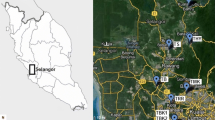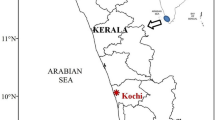Abstract
Effluents originating from pesticides, agro-chemicals, textile dyes and dyestuffs industries are always associated with high turbidity, colour, nutrient load, and heavy metals, toxic and persistent compounds. But even with such an anthropogenic nature, these effluents contain dynamic cyanobacterial communities. Documentation of cyanobacterial cultures along the water channels of effluents discharged by above mentioned industries along the west coast of India and their relationship with water quality is reported in this study. Intensity of pollution was evaluated by physico-chemical analysis of water. Higher load of solids, carbon and nutrients were found to be persistent throughout the analysis. Sediment and water samples were found to be colored in nature. Cyanobacterial community structure was found to be influenced by the anthropogenic pollution. 40 different cyanobacterial species were recorded from 14 genera of 5 families and an elevated occurrence of Phormidium, Oscillatoria and Chroococcus genera was observed in all the sampling sites.
Similar content being viewed by others
References
A. P. H. A.: 1995, Standard Methods for the Examination of Water and Wastewater, 19th edn., American Public Health Association, NewYork, USA.
Aboal, M.: 1989, “Epilithic algal communities from River Segura Basin, Southeastern Spain”, Arch. Hydrobiol. 116, 113–124.
Douterelo, I., Perona, E. and Mateo, P.: 2004, “Use of cyanobacteria to assess water quality in running waters”, Environ. Poll. 127, 377–384.
Garcia-pichel, F., Nubel, U., Muyzer, G. and Kuhl, M.: 1999, “Cyanobacterial community diversity and its quantification”, in: C. R. Bell, M. Brylinsky and G. P. Johnson (eds), Microbial Biosystems: New Frontiers, Proceedings of 8th International Symposium on Microbial Ecology, Atlantic Canada Society for Microbial Ecology, Halifax, Canada.
Gupta, R. S. and Geetanjali, D.: 2000, Coastal and Maritime Environments of Gujarat: Ecology and Economics, Gujarat Ecological Society, Gujarat, India, pp. 150.
Havensa, K. E., Thomas, R. J., Easta, T. L. and Smith, V. H.: 2003, “N:P ratios, light limitation, and cyanobacterial dominance in a subtropical lake impacted by non-point source nutrient pollution”, Environ. Poll. 122, 379–390.
Kowalewska, G., Konat-Stepowicz, J., Wawrzyniak, W. B. and Szymczak-Zyla, M.: 2003, “Transfer of organic contaminants to the Baltic in the Odra Estuary”, Mar. Poll. Bull. 46, 703–718.
Kowalewska, G.,WawrzyniakW. B. and Szymczak-Zyla, M.: 2004, “Chlorophyll a and its derivatives in sediments of the Odra estuary as a measure of its eutrophication”, Mar. Poll. Bull. 49, 148–153.
Kufel, L.: 2001, “Uncoupling of chlorophyll and nutrients in lakes-possible reasons, expected consequences”, Hydrobiology 443(1–3), 59–67.
Labunska, I., Stephenson, A., Brigden, K., Stringer, R., Santillo, D., Johnston, P. A. and Ashton, J. M.: 1999, Toxic Hotspots: A Greenpeace Investigation of Gujarat Industrial Estates Organic and Heavy Metal Contaminants in Samples Taken at Three Industrial Estates in Gujarat, India.
Mazgaonkar, M.: 2001, “Toxic Corridors”, Available from http://www.indiatogether.org/stories/gidcpss.htm, September 2001.
Miloslav, K. and Aloisie, P.: 2003, “Litoral diatoms as indicators for the eutrophication of shallow lakes”, Hydrobiology 506–509(1–3), 519–524.
Moisander, P. H., Hench, J. L., Kononen, K. and Paerl, H. W.: 2002, “Small-scale shear effects on heterocystous cyanobacteria”, Limnol. Oceano. 47, 108–119.
Murrell, M. C. and Lores, E. M.: 2004, “Phytoplankton and zooplankton seasonal dynamics in subtropical estuary: Importance of cyanobacteria”, J. Plank. Res. 26(3), 371–382.
Pace, N. R.: 1997, “A molecular view of microbial diversity and the biosphere”, Science 276, 734–740.
Paerl, H. W., Dyble, J., Moisander, P. H., Noble, R. T., Piehler, M. F., Pinckney, J. L., Steppe, T. F., Twomey, L. and Valdes, L. M.: 2003, “Microbial indicators of aquatic ecosystem change: Current applications to eutrophication studies”, FEMS Microbiol. Ecol. 46, 233–246.
Rott, E. and Pfister, P.: 1988, “Natural epilithic algal communities in fast-flowing mountain streams and rivers and some man-induced changes”, Verh. Internat. Verein. Limnol. 23, 1320–1324.
Scheffer, M., Rinaldi, S., Gragnani, A., Mur, L. R. and van Nes, E. H.: 1997, “On the dominance of filamentous cyanobacteria in shallow turbid lakes”, Ecology. 78, 277–282.
Shah, V., Garg, N. and Madamwar, D.: 2000, “Record of the cyanobacteria present in the Hamisar pond of Bhuj, India”, Act. Bot. Mala. 25, 175–180.
Shah, V., Garg, N. and Madamwar, D.: 2000, “Record of the cyanobacteria present in the Hamisar pond of Bhuj, India”, Act. Bot. Mala. 25, 175–180.
Smith, V. H.: 1983, “Low nitrogen to phosphorus ratios favor dominance by blue-green algae in lake phytoplankton”, Science 221, 669–671.
Telesh, I. V.: 2004, “Plankton of the Baltic estuarine ecosystems with emphasis on Neva Estuary: A review of present knowledge and research perspectives”, Mar. Poll. Bull. 49, 206–219.
Tiedje, J. M.: 1995, Approaches to the Comprehensive Evaluation of Prokaryote Diversity of a Habitat, in Microbial Diversity and Ecosystem Function, CAB International, Oxon, UK, pp. 73–87.
Turner, R. E., Rabalais, N. N., Justic, D. and Dortch, Q.: 2003, “Future aquatic nutrient limitations”, Mar. Poll. Bull. 46, 1032–1034.
Vigdis, T. and Lise, O.: 2002, “Microbial diversity and function in soil: From genes to ecosystems”, Curr. Opin. Microbiol. 5, 240–245.
Wentzel, M. C., George, A. E. and Loewenthal, R. E.: 2003, Fundamentals of Biological Behaviour and Wastewater Strength Tests, Academic Press, UK, pp. 145–173.
Wu, R. S. S.: 1999, “Eutrophication, water borne pathogens and xenobiotic compounds: Environmental risks and challenges”, Mar. Poll. Bull. 39(1–12), 11–22.
Author information
Authors and Affiliations
Corresponding author
Rights and permissions
About this article
Cite this article
Parikh, A., Shah, V. & Madamwar, D. Cyanobacterial Flora from Polluted Industrial Effluents. Environ Monit Assess 116, 91–102 (2006). https://doi.org/10.1007/s10661-006-7229-x
Received:
Accepted:
Issue Date:
DOI: https://doi.org/10.1007/s10661-006-7229-x




